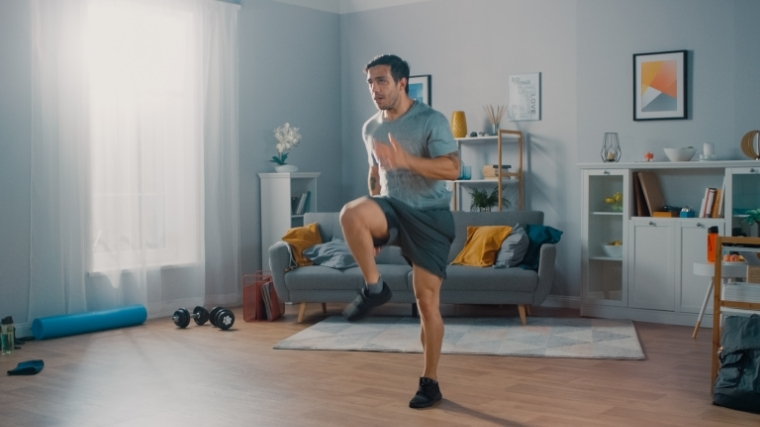No matter how dedicated you might be, there are going to be times when getting to the gym might be difficult or impossible — either due to a hectic work/life schedule or a global pandemic shutting down businesses everywhere. While a day off here and there won’t kill you, you don’t want to go too long without stressing your muscles.
Most studies have shown that muscle atrophy — the act of your muscles getting smaller — can start two weeks after you stop regularly exercising and strength gains can diminish within a month. This isn’t a concrete number, as more experienced lifters might be able to hold onto their muscles for longer.
To that end, we’ve reached out to Jesse Irizarry, a strength and conditioning coach with more than 15 years of experience, to give us four workout programs you can do from home to keep you in shape and ready for your return to the iron paradise.
Best Home Workouts
- Bodyweight Tempo Pairings
- Bodyweight Density Training
- Resistance Band Exercises for Time
- 100-Rep Sets
- Home Workout Training Tips
Bodyweight Tempo Pairings
A 2017 study found that push-ups and bench-pressing 40 percent of your one-rep max resulted in similar gains. (1) So while you won’t get Mr. Olympia-sized huge by just using your body weight, it’s certainly better than doing nothing. In other words: don’t discount bodyweight exercises.

[Read More: The Best Home Gym Equipment, Tested and Verified by Experts]
For this program, you’ll pick an upper- and lower-body compound movement (a push-up and bodyweight squat, for example). Then, choose a tempo to complete the exercises. Irizarry recommends a 6-0-6-0 tempo— six seconds down, no pause, six seconds up, no pause, and repeat.
So for the push-up, you’ll take six seconds to reach the bottom and then immediately go back up, taking six seconds to reach the top.
Time how long it takes you to complete eight reps of the first movement and rest for that amount of time before doing the next move (about 100 seconds). You’ll then time how long it takes you to complete the second move and rest for one-and-a-half that amount of time — e.g. if it takes you 60 seconds, rest for 90 — before completing another circuit. Aim for eight rounds.
“Very slow, controlled bodyweight movements done with a good amount of volume like this strengthen connective tissue — tendons and ligaments — which keeps your body healthy from injury and helps the body create for force,” Irizarry tells BarBend. “In many ways, this can be even more effective in improving general strength capacity and muscular size than other methods that use resistance bands because of the continuous tension both in the concentric and eccentric portion of the movements.”
You can also do more sets of just one pairing or do another two exercises using the same format if you’re looking for an extra challenge.
Example workout:
- A1: Bodyweight Squat for eight reps (tempo: 6-0-6-0)
Rest duration it took to complete A1
- A2: Pike Push-Ups for 10 reps (tempo: 6-0-6-0)
Rest 1.5-times duration it took to complete A2 and repeat for 7 more sets.
Bodyweight Density Training
If conditioning is your goal, this is the program for you.
“This is a great method to progress over multiple weeks of training,” Irizarry says. “You can record how many times you got through the circuit the first time you do it and then try to get through it more times the next time you do it. Once you’ve done that, you can progress more and build an even higher work capacity by adding more time. Increasing it by two minutes is a good rule of thumb.”

[Read More: The Best Bodyweight Exercises, + Workouts and Tips From a CPT]
You’ll pick three bodyweight moves you can do with good, accurate form and a moderate number of reps for each. Then pick a time limit to complete as many rounds of the moves as possible — start with eight minutes. Cycle through all three exercises, resting in between moves as needed, as many times as possible during the time limit.
Example workout:
- Split Squat for five reps each leg
Rest as needed
- Push-Up for six reps
Rest as needed
- Glute Bridge for eight reps
Rest as needed
Resistance Band Exercises for Time
Resistance bands are not only smaller and more portable than heavy dumbbells, but they’re cheaper and more widely available on the internet, too. A 2019 study also found they provide “similar” strength gains compared to free weights or machines (2)
Similar to lifting free weights, you’ll want to find a band that’s not so resistant you struggle to get one rep but also not light enough that you can do 100 with ease. A good rule of thumb is to use a load that has you failing two to three reps past your intended rep count.

For this program, pick three to six moves — they can be compound or isolation. Set a timer for 45-60 seconds and pump out as many reps of possible (AMRAP) of your first move before resting two to three minutes and then moving onto your next move.
“This method is great for building local muscular endurance and the metabolic stress from doing so many reps cause muscles to grow,” Irizarry says. “This is also great for fat loss.”
Example workout:
- Resistance Band Good Morning for AMRAP in 45 seconds
Rest two to three minutes
- Resistance Band Triceps Push Down for AMRAP in 60 seconds
Rest two to three minutes
- Resistance Band Upright Row for AMRAP in 45 seconds
Rest two to three minutes
- Resistance Band Push-Up for AMRAP in 60 seconds
100-Rep sets
“This method is great for anaerobic conditioning and will help with fat loss as well as muscle gain,” Irizarry says. But be forewarned, it’s not for the faint of heart.
You’ll pick two to four moves, either with just your bodyweight, with resistance bands, or both. Do 100 reps of your first move, resting as necessary, before resting three to five minutes and continuing onto your next.
Example workout:
- Bodyweight Squat for 100 reps
Rest three to five minutes
- Incline Push-Up for 100 reps
Rest three to five minutes
- Band Row for 100 reps
Home Workout Training Tips
There can be challenges associated with keeping your workouts at home. Here are a few tips to ensure your training sessions are productive and intense.
Stick to a Schedule
If you work from home or are simply taking an extended vacation, it can be difficult to separate work from play. Your kitchen and bed are mere feet away, so pushing your wake up time an hour or extending lunch time is easy. Don’t fall into this trap. By adhering to a schedule, you’re setting yourself up for success. Otherwise, that 45-minute workout you planned on doing can easily fall victim to another episode on Netflix. Pick a workout time, and stick to it.
Don’t Watch TV
It’s tempting to turn on the tube while banging out sets of squats or push-ups, but this can also be distracting. Yes, doing the work counts — but so does intensity. If you’re just underperforming through your sets, then you most likely won’t see much progress. For the hour (or half hour) you’re training, throw on some headphones, and treat your living room like Gold’s Gym (Then, be thankful that you get to shower at home and not Gold’s Gym.)
Invest in Some Equipment
Bodyweight training is effective, but having tools like a nice pair of kettlebells, adjsutable dummbells, a workout bench (or even a squat rack if your have the space), you’ll be both more motivated and primed to progress. Weights afford you another way to load the muscle. After all, you can only do so many push-ups before you burn out, and having weights affords you a larger selection of exercises to use.
More At-Home Training Content
You don’t need an iron paradise to reap serious gains. With some discipline, know-how, and the best home workout programs, you can build a great body — and get healthier — from the comfort of your living room. Here are some other at-home workout articles worth checking out.
- How to Fix Common Strength Training Mistakes
- Best At-Home Bodyweight Workouts
- How to Create an At-Home Workout Routine
- 8 Muscle-Building Home Workouts From Top Athletes and Coaches
References
1. Kikuchi, N., & Nakazato, K. (2017). Low-load bench press and push-up induce similar muscle hypertrophy and strength gain. Journal of Exercise Science & Fitness, 15(1), 37–42. https://doi.org/10.1016/j.jesf.2017.06.003
2. Lopes JSS, Machado AF, Micheletti JK, de Almeida AC, Cavina AP, Pastre CM. Effects of training with elastic resistance versus conventional resistance on muscular strength: A systematic review and meta-analysis [published correction appears in SAGE Open Med. 2020 Sep 9;8:2050312120961220]. SAGE Open Med. 2019;7:2050312119831116. Published 2019 Feb 19. doi:10.1177/2050312119831116
Feature image: Gorodenkoff/Shutterstock